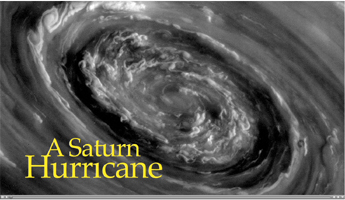Saturn Hurricane Movie

Click on the image for the animation
This movie, made from images obtained by NASA's Cassini spacecraft, shows the clouds of a hurricane-like storm, which circulate around the north pole of Saturn out to 88.5 degrees north latitude. The latitude of the bright ring of clouds is 89.0 degrees, which is about 587 miles (945 kilometers) from the pole. The eye of the storm is about 50 times larger than the average hurricane eye on Earth.
Winds are measured by following small clouds over a five-hour period. The winds at the inner ring are moving the fastest, at speeds of about 340 mph (150 meters per second) relative to the nominal rate for the planet established by NASA's Voyager spacecraft in 1980. These winds are four times the speed of the Earth's jet streams and more than four times the definition of a hurricane force wind on Earth. (Hurricane force winds blow at 74 mph, or 119 kilometers per hour.)
The clouds at the very center are spinning rapidly -- almost twice as fast as the planet itself, with a period just over six hours. The direction of rotation is counterclockwise, like a northern hemisphere hurricane on Earth, except there is no ocean underneath. A similar feature exists at Saturn's southern pole, and it spins in the same direction as that of a southern hemisphere hurricane on Earth. However, the hurricanes on Earth begin in the tropics and drift around. The polar hurricanes on Saturn are locked to their poles.
The bright clouds form a tightly wrapped spiral that traces a path toward the center as one follows it in a counterclockwise direction. This spiral could be a wave or actual particle motion toward the center from a disturbance further out. Or it could be the remnants of a compact cloud that got sheared apart by the higher angular velocity closer to the center. Choosing among these possibilities is the subject of ongoing research. Other ongoing research involves inferring cloud heights, both from the changing shadows as the sun moves relative to the features, and from the appearance of the clouds in other wavelengths, not shown in this set of black and white images.
This set of images is among the first sunlit views of Saturn's north pole captured by Cassini's imaging cameras. When the spacecraft arrived in the Saturnian system in 2004, it was northern winter and the north pole was in darkness.
The movie was constructed from seven images taken over five hours by Cassini's imaging science subsystem when the spacecraft was about 45 degrees above the horizon. Imaging team scientists re-projected the images to show a view from directly over the pole, keeping up with the rotation of the planet to make the clouds at 89.3 degrees latitude appear stationary. The winds at other latitudes produce the motion seen on the screen. They determined the rotation rate at each latitude, and interpolated in time to make a 200-step movie that flows smoothly as the clouds swirl around the center. To show the features at the center, the movie displays the motion relative to the clouds at 89.3 degrees latitude.
A higher-resolution movie shows 1,680 steps that flow smoothly at 60 frames per second. This version includes a small circle going around the outside that gives the position of the sun during the five-hour observation period.
The Cassini-Huygens mission is a cooperative project of NASA, the European Space Agency and the Italian Space Agency. NASA's Jet Propulsion Laboratory, a division of the California Institute of Technology in Pasadena, manages the mission for NASA's Science Mission Directorate, Washington, D.C. The Cassini orbiter and its two onboard cameras were designed, developed and assembled at JPL. The imaging operations center is based at the Space Science Institute in Boulder, Colo.
For more information about the Cassini-Huygens mission, visit: http://www.nasa.gov/cassini and http://saturn.jpl.nasa.gov.. The Cassini imaging team homepage is at http://ciclops.org.
